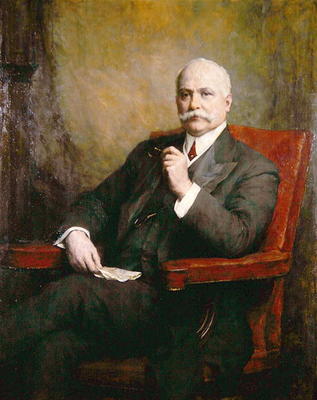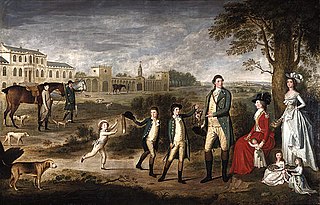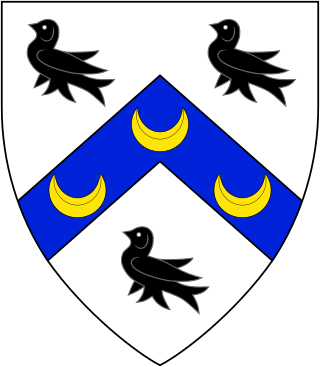
Earl of Rosslyn is a title in the Peerage of the United Kingdom. It was created in 1801 for Alexander Wedderburn, 1st Baron Loughborough, Lord Chancellor from 1793 to 1801, with special remainder to his nephew Sir James St Clair-Erskine, as Wedderburn had no surviving issue of his own. Wedderburn had already been created Baron Loughborough, of Loughborough in the County of Leicester, in the Peerage of Great Britain in 1780, with normal remainder to the heirs male of his body, and Baron Loughborough, of Loughborough in the County of Surrey, in the Peerage of Great Britain in 1795, with the same remainder as the earldom. The 1780 barony became extinct upon his death, but the 1795 barony and the earldom passed, by the special remainder, to his nephew, who thus became the second Earl of Rosslyn. The second Earl was a Lieutenant-General in the Army and also held political office as Lord Privy Seal and Lord President of the Council.

James Francis Harry St Clair-Erskine, 5th Earl of Rosslyn, styled Lord Loughborough until 1890, was a Scottish soldier, author and aristocrat.

There have been three baronetcies created for persons with the surname Holden, all in the Baronetage of the United Kingdom. Two of the creations are extant as of 2010.
Nineteen baronetcies have been created for persons with the surname Hamilton, eight in the Baronetage of Nova Scotia, one in the Baronetage of England, five in the Baronetage of Ireland, one in the Baronetage of Great Britain and four in the Baronetage of the United Kingdom. As of 2008 two creations are extant, two are dormant, two are either extinct or dormant and twelve extinct.

There have been five baronetcies of the United Kingdom created for a person with the surname Erskine, two in the Baronetage of Nova Scotia, one in the Baronetage of Great Britain and two in the Baronetage of the United Kingdom. Two of the creations are extant as of 2010.
There have been three baronetcies created for persons with the surname North, one in the Baronetage of England and two in the Baronetage of the United Kingdom. Two creations are extinct while one is extant. The last creation passed into the North family through marriage.

There have been twenty one baronetcies created for persons with the surname Williams, eight in the Baronetage of England, three in the Baronetage of Great Britain and ten in the Baronetage of the United Kingdom. Only six of the creations are extant as of 2017.
The Douglas of Glenbervie, Kincardine Baronetcy was created on 28 May 1625 in the Baronetage of Nova Scotia.
There have been five baronetcies created for persons with the surname Hill, one in the Baronetage of Nova Scotia, one in the Baronetage of Great Britain, one in the Baronetage of Ireland and two in the Baronetage of the United Kingdom. Three of the creations are extant as of 2008.

There have been four baronetcies created for persons with the surname Miller, two in the Baronetage of England, one in the Baronetage of Great Britain and one in the Baronetage of the United Kingdom. Two of the creations are extant as of 2008.
There have been three baronetcies created for persons with the surname Harrison, all in the Baronetage of the United Kingdom. As of 2007 one of the creations is extinct while two are extant.
There have been two baronetcies created for persons with the surname Borthwick, both in the Baronetage of the United Kingdom.
There have been four baronetcies created for persons with the surname Bell, all in the Baronetage of the United Kingdom. One creation is extant as of 2007.
There have been two baronetcies created for persons with the surname Gray, one in the Baronetage of Nova Scotia and one in the Baronetage of the United Kingdom. One creation is extant as of 2007.
There have been two Ritchie baronetcies created in the Baronetage of the United Kingdom for members of the Ritchie family. Both creations are extinct.
There have been two baronetcies created for persons with the surname Dunlop, with both in the Baronetage of the United Kingdom. One creation is extant as of 2007.

There have been seven baronetcies created for persons with the surname Watson, one in the Baronetage of England, one in the Baronetage of Great Britain and five in the Baronetage of the United Kingdom. One creation is extant as of 2016.
Anthony Hugh Francis Harry St Clair-Erskine, styled Lord Loughborough from 1929 to 1939, was a British peer. The Earl's lands included the noted Rosslyn Chapel.

Canadian peers and baronets exist in both the peerage of France recognized by the Monarch of Canada and the peerage of the United Kingdom.







